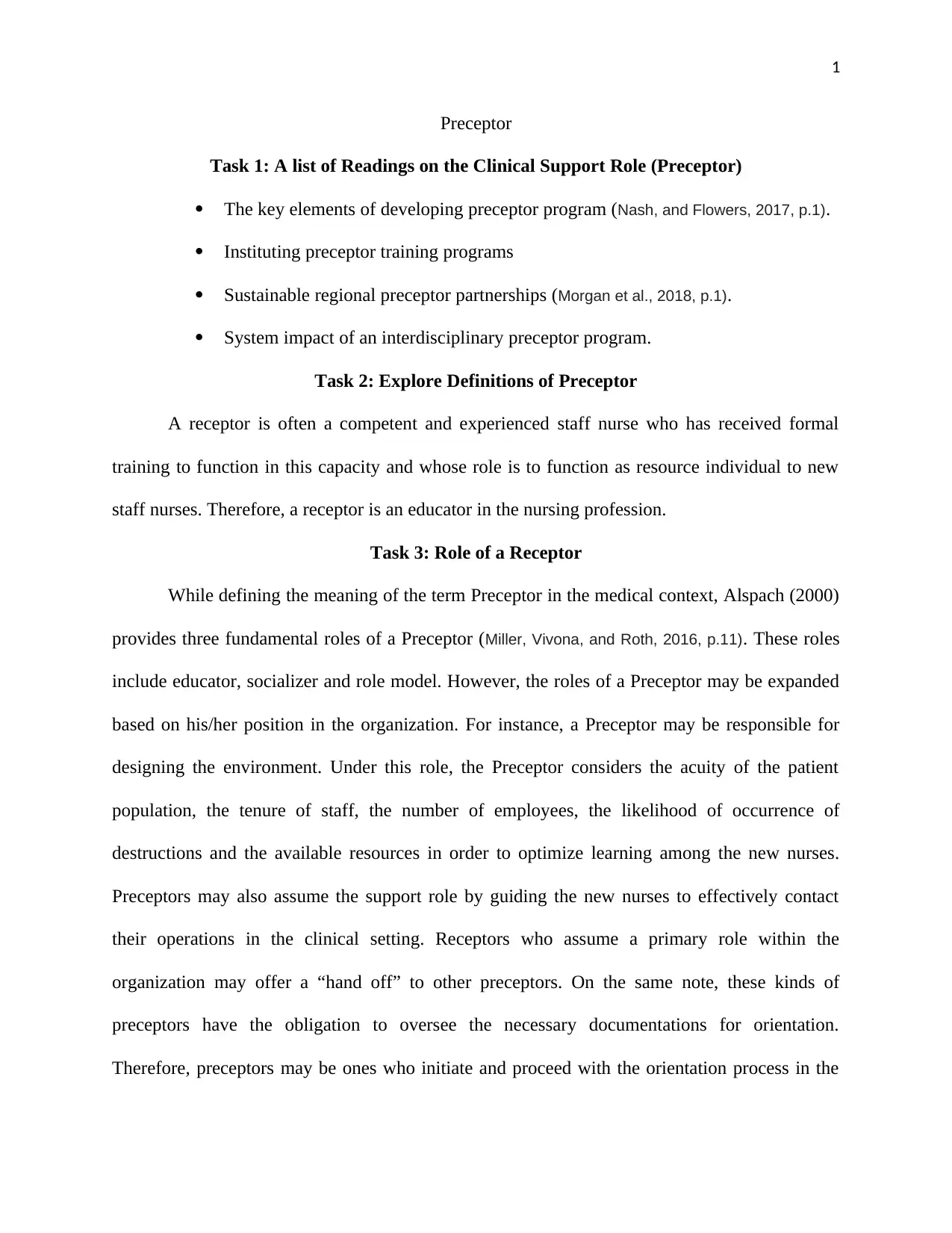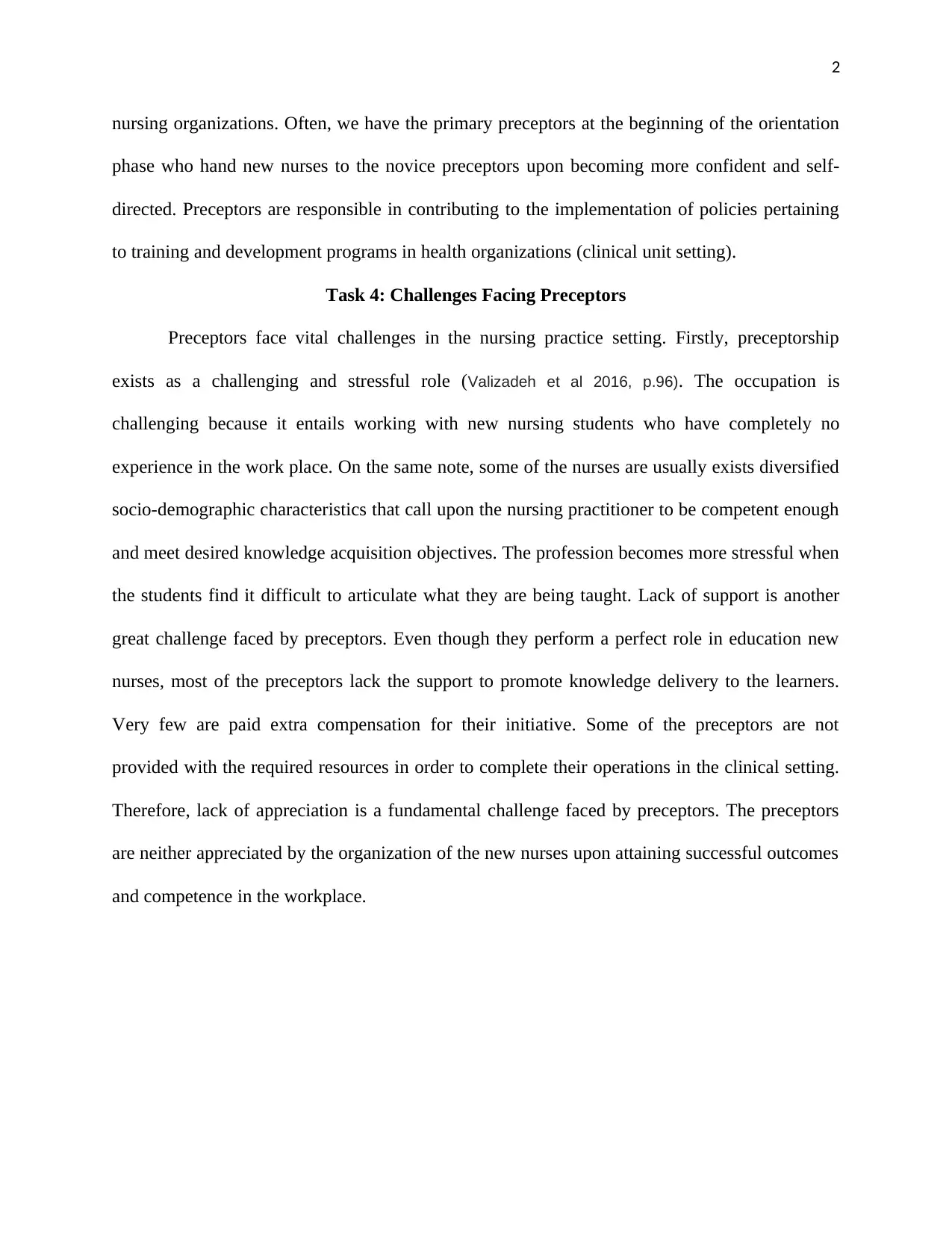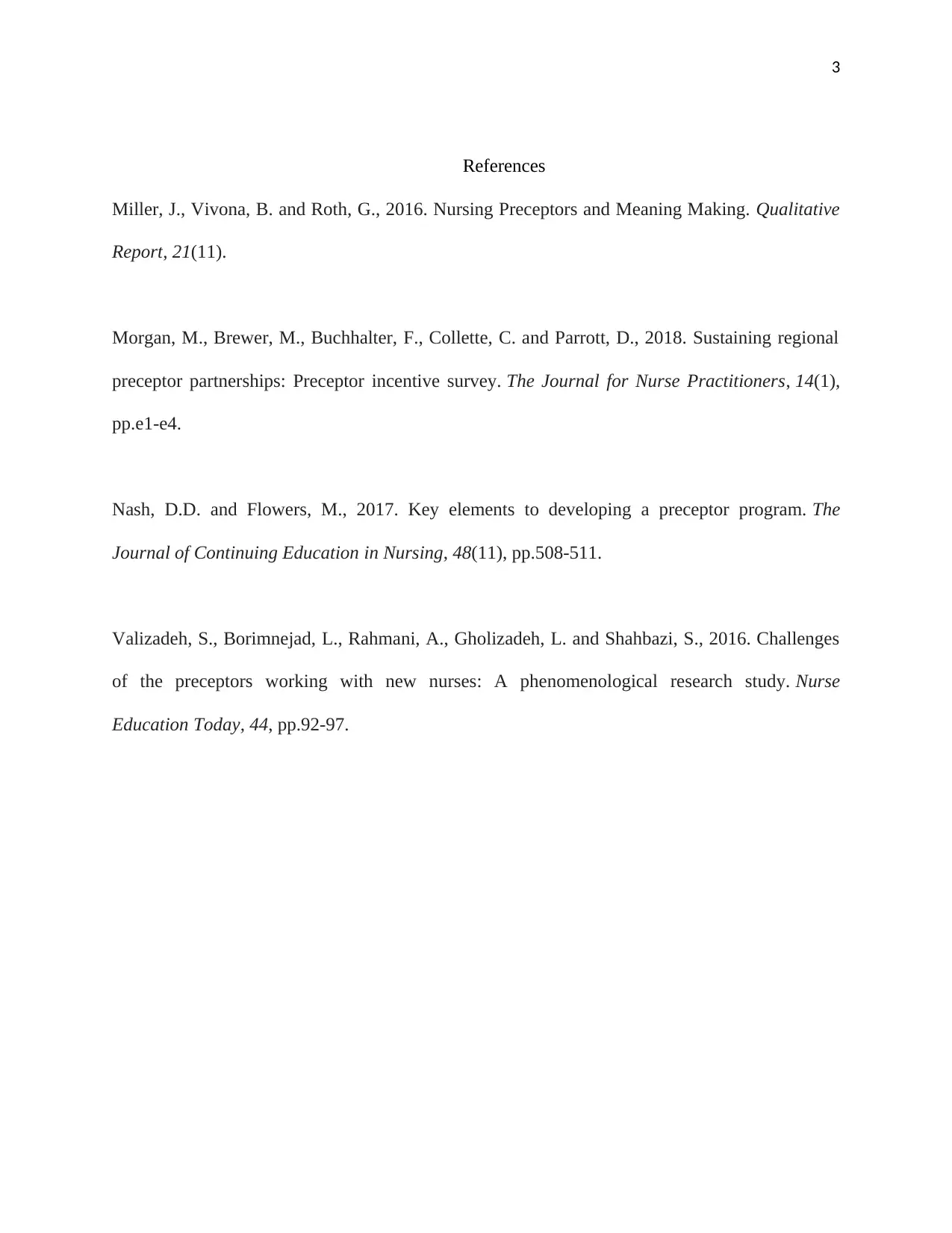Preceptor Report: Exploring Definitions, Roles, and Current Issues
VerifiedAdded on 2022/07/28
|4
|755
|28
Report
AI Summary
This report examines the role of a preceptor in a clinical setting, focusing on definitions, responsibilities, and the challenges faced. It begins with a literature review, presenting key readings on the preceptor role and the development of preceptor programs. The report defines a preceptor as an experienced nurse educator who supports new staff nurses. It then outlines the educator, socializer, and role model roles of a preceptor, including designing the learning environment and offering support. The report also explores challenges faced by preceptors, such as the stress of the role, lack of support, and insufficient appreciation. References to relevant literature are included to support the findings.

0
PRECEPTOR
Student’s Name
Preceptor
Course Studied
Course Code
City
State
Date
PRECEPTOR
Student’s Name
Preceptor
Course Studied
Course Code
City
State
Date
Paraphrase This Document
Need a fresh take? Get an instant paraphrase of this document with our AI Paraphraser

1
Preceptor
Task 1: A list of Readings on the Clinical Support Role (Preceptor)
The key elements of developing preceptor program (Nash, and Flowers, 2017, p.1).
Instituting preceptor training programs
Sustainable regional preceptor partnerships (Morgan et al., 2018, p.1).
System impact of an interdisciplinary preceptor program.
Task 2: Explore Definitions of Preceptor
A receptor is often a competent and experienced staff nurse who has received formal
training to function in this capacity and whose role is to function as resource individual to new
staff nurses. Therefore, a receptor is an educator in the nursing profession.
Task 3: Role of a Receptor
While defining the meaning of the term Preceptor in the medical context, Alspach (2000)
provides three fundamental roles of a Preceptor (Miller, Vivona, and Roth, 2016, p.11). These roles
include educator, socializer and role model. However, the roles of a Preceptor may be expanded
based on his/her position in the organization. For instance, a Preceptor may be responsible for
designing the environment. Under this role, the Preceptor considers the acuity of the patient
population, the tenure of staff, the number of employees, the likelihood of occurrence of
destructions and the available resources in order to optimize learning among the new nurses.
Preceptors may also assume the support role by guiding the new nurses to effectively contact
their operations in the clinical setting. Receptors who assume a primary role within the
organization may offer a “hand off” to other preceptors. On the same note, these kinds of
preceptors have the obligation to oversee the necessary documentations for orientation.
Therefore, preceptors may be ones who initiate and proceed with the orientation process in the
Preceptor
Task 1: A list of Readings on the Clinical Support Role (Preceptor)
The key elements of developing preceptor program (Nash, and Flowers, 2017, p.1).
Instituting preceptor training programs
Sustainable regional preceptor partnerships (Morgan et al., 2018, p.1).
System impact of an interdisciplinary preceptor program.
Task 2: Explore Definitions of Preceptor
A receptor is often a competent and experienced staff nurse who has received formal
training to function in this capacity and whose role is to function as resource individual to new
staff nurses. Therefore, a receptor is an educator in the nursing profession.
Task 3: Role of a Receptor
While defining the meaning of the term Preceptor in the medical context, Alspach (2000)
provides three fundamental roles of a Preceptor (Miller, Vivona, and Roth, 2016, p.11). These roles
include educator, socializer and role model. However, the roles of a Preceptor may be expanded
based on his/her position in the organization. For instance, a Preceptor may be responsible for
designing the environment. Under this role, the Preceptor considers the acuity of the patient
population, the tenure of staff, the number of employees, the likelihood of occurrence of
destructions and the available resources in order to optimize learning among the new nurses.
Preceptors may also assume the support role by guiding the new nurses to effectively contact
their operations in the clinical setting. Receptors who assume a primary role within the
organization may offer a “hand off” to other preceptors. On the same note, these kinds of
preceptors have the obligation to oversee the necessary documentations for orientation.
Therefore, preceptors may be ones who initiate and proceed with the orientation process in the

2
nursing organizations. Often, we have the primary preceptors at the beginning of the orientation
phase who hand new nurses to the novice preceptors upon becoming more confident and self-
directed. Preceptors are responsible in contributing to the implementation of policies pertaining
to training and development programs in health organizations (clinical unit setting).
Task 4: Challenges Facing Preceptors
Preceptors face vital challenges in the nursing practice setting. Firstly, preceptorship
exists as a challenging and stressful role (Valizadeh et al 2016, p.96). The occupation is
challenging because it entails working with new nursing students who have completely no
experience in the work place. On the same note, some of the nurses are usually exists diversified
socio-demographic characteristics that call upon the nursing practitioner to be competent enough
and meet desired knowledge acquisition objectives. The profession becomes more stressful when
the students find it difficult to articulate what they are being taught. Lack of support is another
great challenge faced by preceptors. Even though they perform a perfect role in education new
nurses, most of the preceptors lack the support to promote knowledge delivery to the learners.
Very few are paid extra compensation for their initiative. Some of the preceptors are not
provided with the required resources in order to complete their operations in the clinical setting.
Therefore, lack of appreciation is a fundamental challenge faced by preceptors. The preceptors
are neither appreciated by the organization of the new nurses upon attaining successful outcomes
and competence in the workplace.
nursing organizations. Often, we have the primary preceptors at the beginning of the orientation
phase who hand new nurses to the novice preceptors upon becoming more confident and self-
directed. Preceptors are responsible in contributing to the implementation of policies pertaining
to training and development programs in health organizations (clinical unit setting).
Task 4: Challenges Facing Preceptors
Preceptors face vital challenges in the nursing practice setting. Firstly, preceptorship
exists as a challenging and stressful role (Valizadeh et al 2016, p.96). The occupation is
challenging because it entails working with new nursing students who have completely no
experience in the work place. On the same note, some of the nurses are usually exists diversified
socio-demographic characteristics that call upon the nursing practitioner to be competent enough
and meet desired knowledge acquisition objectives. The profession becomes more stressful when
the students find it difficult to articulate what they are being taught. Lack of support is another
great challenge faced by preceptors. Even though they perform a perfect role in education new
nurses, most of the preceptors lack the support to promote knowledge delivery to the learners.
Very few are paid extra compensation for their initiative. Some of the preceptors are not
provided with the required resources in order to complete their operations in the clinical setting.
Therefore, lack of appreciation is a fundamental challenge faced by preceptors. The preceptors
are neither appreciated by the organization of the new nurses upon attaining successful outcomes
and competence in the workplace.
⊘ This is a preview!⊘
Do you want full access?
Subscribe today to unlock all pages.

Trusted by 1+ million students worldwide

3
References
Miller, J., Vivona, B. and Roth, G., 2016. Nursing Preceptors and Meaning Making. Qualitative
Report, 21(11).
Morgan, M., Brewer, M., Buchhalter, F., Collette, C. and Parrott, D., 2018. Sustaining regional
preceptor partnerships: Preceptor incentive survey. The Journal for Nurse Practitioners, 14(1),
pp.e1-e4.
Nash, D.D. and Flowers, M., 2017. Key elements to developing a preceptor program. The
Journal of Continuing Education in Nursing, 48(11), pp.508-511.
Valizadeh, S., Borimnejad, L., Rahmani, A., Gholizadeh, L. and Shahbazi, S., 2016. Challenges
of the preceptors working with new nurses: A phenomenological research study. Nurse
Education Today, 44, pp.92-97.
References
Miller, J., Vivona, B. and Roth, G., 2016. Nursing Preceptors and Meaning Making. Qualitative
Report, 21(11).
Morgan, M., Brewer, M., Buchhalter, F., Collette, C. and Parrott, D., 2018. Sustaining regional
preceptor partnerships: Preceptor incentive survey. The Journal for Nurse Practitioners, 14(1),
pp.e1-e4.
Nash, D.D. and Flowers, M., 2017. Key elements to developing a preceptor program. The
Journal of Continuing Education in Nursing, 48(11), pp.508-511.
Valizadeh, S., Borimnejad, L., Rahmani, A., Gholizadeh, L. and Shahbazi, S., 2016. Challenges
of the preceptors working with new nurses: A phenomenological research study. Nurse
Education Today, 44, pp.92-97.
1 out of 4
Related Documents
Your All-in-One AI-Powered Toolkit for Academic Success.
+13062052269
info@desklib.com
Available 24*7 on WhatsApp / Email
![[object Object]](/_next/static/media/star-bottom.7253800d.svg)
Unlock your academic potential
Copyright © 2020–2025 A2Z Services. All Rights Reserved. Developed and managed by ZUCOL.





